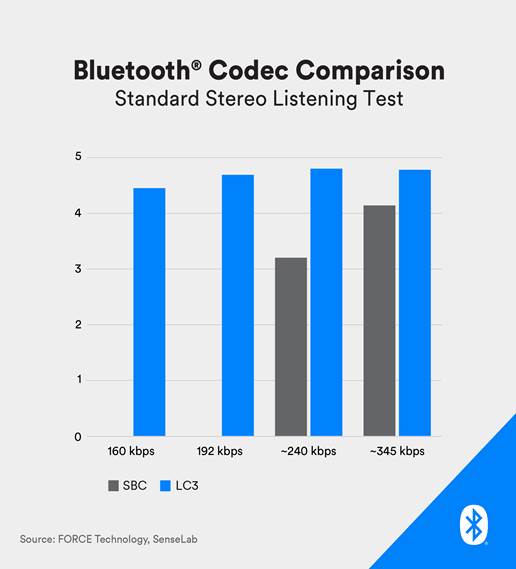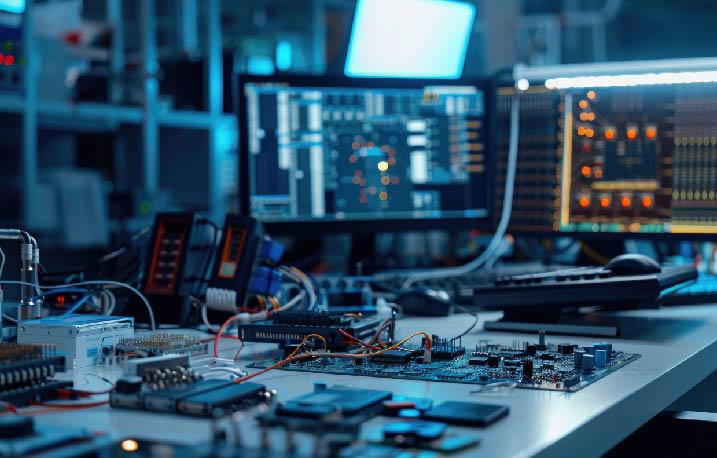According to the Bluetooth Association’s 2023 report, by 2027, there is estimated to be about 7 billion Bluetooth devices worldwide, of which 1.5 billion will be audio. As indicated in the figure below, LE-only audio devices are expected to gradually replace the classic Bluetooth audio profile (A2DP) within the next five years, and products that are more power-saving, feature better sound quality and higher compression rates, and are better suited to individual use are becoming more common.

Bluetooth LE Audio is an emerging technology supported by Bluetooth specification 5.2 and above, which enables high-quality audio transmission. It uses LC3 encoding, which offers effective audio compression and produces a better-quality sound.
LC3 encoding is a low-latency audio coding technology typically used for video conferencing and audio calls. While maintaining minimal latency, it allows for efficient compression and high-caliber audio output.
The compression efficiency of LC3 encoding is higher than that of traditional audio codecs, allowing the LC3 codec to deliver better-quality audio at the same data transfer rates. LC3 encoding is also more fault-tolerant and can maintain superior sound quality even in poor network conditions.
What’s more, LC3 encoding supports variable bit rate (VBR), which means that encoders can automatically adjust the encoding rate based on the complexity of audio signals during transmission, resulting in more efficient compression and allowing for a better audio experience with higher-quality audio transmission and storage.
Compared with Bluetooth SBC encoding, LC3 encoding delivers better sound at the same – or even lower – transmission rates, which offers developers great flexibility in the design of their products and the freedom to balance sound quality with power consumption to achieve the best results. The comparison between LC3 encoding and SBC encoding is as follows:

Source: Bluetooth SIG
There are several ways to determine audio encoding quality. The most common method is to actually listen to the sound before and after compression and decompression. Other options include using standard quantization methods to measure audio encoding performance, a process that is illustrated below.

Source: IEEE 269 Standard
STEP: Send Electrical Test Point
MRP: Mouth Reference Point
HATS: head and torso simulator
Bluetooth LC3 encoding defines an efficient Bluetooth codec for use in audio files, as shown in the figure below. The codec can compress the varying bit rates of speech and music. LC3 is suitable for any Bluetooth audio file to deliver satisfactory sound quality under any channel conditions. LC3 is a block-based conversion audio codec that features low latency, low compression, and a relatively broad range of usable bit rates. Compression and decompression can be done simultaneously in 10 ms and 7.5 ms streaming intervals at 8 kHz, 16 kHz, 24 kHz, 32 kHz, and 48 kHz sampling rates.

Image source: LE Audio Specification, Bluetooth SIG Inc.
LC3 Advantages
Lightweight design ideal for small data load applications
- Low requirement for RAM (less than 10 kW) & ROM (less than 16 kW*) memory
- Lower computing requirements and power draw
Flexible Coding Parameters
- Supports 8, 16, 24, 32, 44.1 and 48 kHz sampling rate
- Supports 16 kbps – 320 kbps bit rate per channel
- Supports high-resolution audio (up to 96 kHz)
- Extra low latency mode (2.5ms and 5ms)
Bluetooth Association offers an LC3 encoding toolkit, which can encode and decode data at a variety of sampling rates and stream lengths, before sequentially generating the encoded and decoded files. As shown in the figure below, the WAVE file format is also recorded and tested to ensure that it does not conflict with the LC3 file format required by the Bluetooth association.

According to the Association’s website, at present, LC3 is supported by a number of products, including Apple Watch 8, the Samsung S23 Ultra smartphone, the iPhone 14 Pro, etc. In addition to Bluetooth chips and modules certification, more than 200 software operating systems have passed LC3 Certification, making LE Audio products an emerging category in consumer electronics.
Allion’s Bluetooth development team provides the following LC3 encoding/decoding format conversion tools, allowing customers to test a variety of audio formats for their LE Audio products. Feel free to contact us if you are interested.

References:
- https://www.bluetooth.com/blog/a-technical-overview-of-lc3/
- IEEE 269 Standard for Measuring Electroacoustic Performance of Communication Devices
- https://www.bluetooth.com/learn-about-bluetooth/recent-enhancements/le-audio/le-audio-specifications/
- https://www.bluetooth.com/bluetooth-resources/mrn-le-audio/
If you want to learn more or have related testing needs, please feel free to contact us . Our service team will gladly help you out.

































